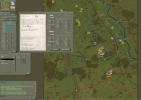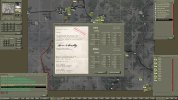BarryJI
Member
I've been playing the living daylights out of Command Ops 2. Or, at least, after reading all the documentation I could find (including the manual) and watching all the tutorial videos, I dove into St. Vith, playing as the Allies, with realistic orders delay and historical weather. I did well but I would love to pose a few questions to some of you vets. Your responses will really help me out and accelerate my understanding of the game. I'm an experienced wargamer but this is the first Brigade and higher scaled game I've played since Decisive Action nearly 20 years ago. It's a marvel.
I pushed harder on the first day than TortugaPower did in his excellent playthrough because I figured it would be a great advantage to have taken St. Vith by sunset on Day 2 and to fight the enemy reinforcements the next day from there, along the main approach roads and from the high ground to the west of the town instead of fighting a running battle on the way in. It worked and by the beginning of Day 2 I had the most amazing positions for three armour battalions along the approach road from the west and on high ground at the northern end of the map. With these forces and plentiful artillery I hammered the Axis reinforcements and stopped the counterattack in its tracks. I thought I was Georgie Patton himself at this point but it was where my problems started. Here are my questions:
- It became a game of whack-a-mole on the night of Day 3 and the next day. Enemy units snuck into all the objectives I had taken and I spent the next 48 hours repelling counter-attacks at all locations, including, humiliatingly, the first objective, the bridge. I did not leave a large enough defensive force at any of the target locations so I had to juggle forces, putting out fires. Some of these battles, against dug-in opposition, were unexpectedly tough. What size force should the player leave around conquered objectives to avoid this happening? Is it worth splitting up a battalion between adjacent objectives and leave them there on guard rather than use them to push north with as much strength as possible?
- The other consequence of my less than adequate rear defense was that enemy units played havoc with my supply lines. Now I wasn't completely careless about this; I probed and cleared all the main routes for motorised units but I had obviously allowed too many battered but not beaten enemy units to roam about behind my front line. This begs another question: should you try and kill everything you meet and not advance until you do? How do you balance this with making the best time to an objective? Should I always be detatching companies to run after retreating enemies after I've broken through?
- Is it possible that, using historical weather, this scenario plays out in an unusual way, because visibility in the snow is really bad during the day (500ft) and non-existent at night? Would it be much easier to play with greater visibility? My playthrough was a bit of a knife-fight and the tanks' range was negated.
- Some things about resupply I don't yet fully understand. I was getting messages that supply convoys to my high-level bases in the rear were being interdicted, but how? My HQ and depot units were not under threat as far as I could see. And why did some of these out-of-harm's way units have to "bunker down"?
In the end I got a Decisive Victory because I was able to recapture all but one of the objectives by ordering tank battalions that were no longer needed around St Vith to sweep back south. There was no surrender but by the scheduled end of the battle I was awarded a Decisive Victory with 520 personnel losses to the Axis' 3629, AFV losses were 121/182, guns 22/115.
This is a truly fantastic game. I want to be good at it. I'd be grateful for all responses to this post. Thanks!
I pushed harder on the first day than TortugaPower did in his excellent playthrough because I figured it would be a great advantage to have taken St. Vith by sunset on Day 2 and to fight the enemy reinforcements the next day from there, along the main approach roads and from the high ground to the west of the town instead of fighting a running battle on the way in. It worked and by the beginning of Day 2 I had the most amazing positions for three armour battalions along the approach road from the west and on high ground at the northern end of the map. With these forces and plentiful artillery I hammered the Axis reinforcements and stopped the counterattack in its tracks. I thought I was Georgie Patton himself at this point but it was where my problems started. Here are my questions:
- It became a game of whack-a-mole on the night of Day 3 and the next day. Enemy units snuck into all the objectives I had taken and I spent the next 48 hours repelling counter-attacks at all locations, including, humiliatingly, the first objective, the bridge. I did not leave a large enough defensive force at any of the target locations so I had to juggle forces, putting out fires. Some of these battles, against dug-in opposition, were unexpectedly tough. What size force should the player leave around conquered objectives to avoid this happening? Is it worth splitting up a battalion between adjacent objectives and leave them there on guard rather than use them to push north with as much strength as possible?
- The other consequence of my less than adequate rear defense was that enemy units played havoc with my supply lines. Now I wasn't completely careless about this; I probed and cleared all the main routes for motorised units but I had obviously allowed too many battered but not beaten enemy units to roam about behind my front line. This begs another question: should you try and kill everything you meet and not advance until you do? How do you balance this with making the best time to an objective? Should I always be detatching companies to run after retreating enemies after I've broken through?
- Is it possible that, using historical weather, this scenario plays out in an unusual way, because visibility in the snow is really bad during the day (500ft) and non-existent at night? Would it be much easier to play with greater visibility? My playthrough was a bit of a knife-fight and the tanks' range was negated.
- Some things about resupply I don't yet fully understand. I was getting messages that supply convoys to my high-level bases in the rear were being interdicted, but how? My HQ and depot units were not under threat as far as I could see. And why did some of these out-of-harm's way units have to "bunker down"?
In the end I got a Decisive Victory because I was able to recapture all but one of the objectives by ordering tank battalions that were no longer needed around St Vith to sweep back south. There was no surrender but by the scheduled end of the battle I was awarded a Decisive Victory with 520 personnel losses to the Axis' 3629, AFV losses were 121/182, guns 22/115.
This is a truly fantastic game. I want to be good at it. I'd be grateful for all responses to this post. Thanks!

